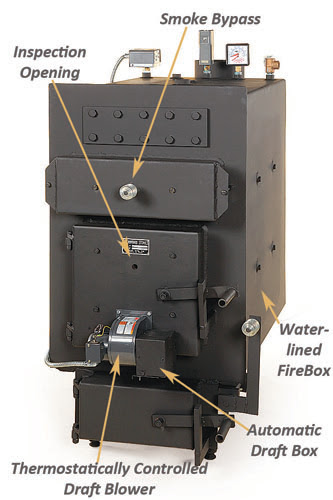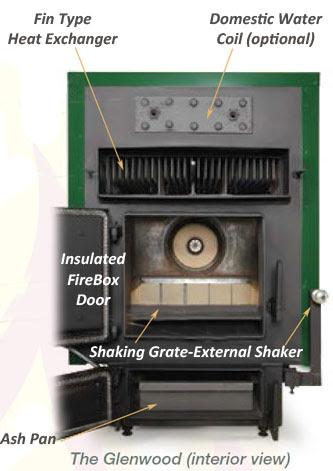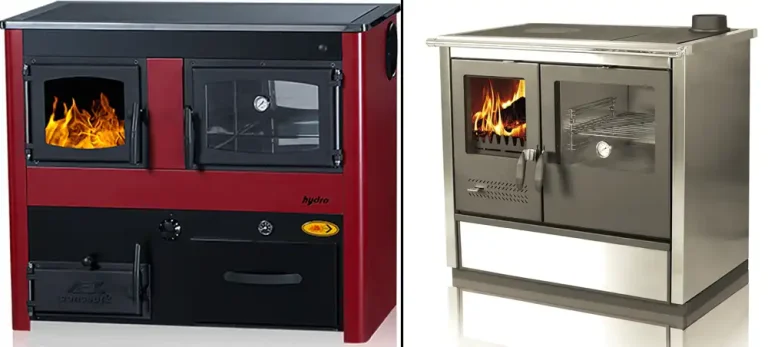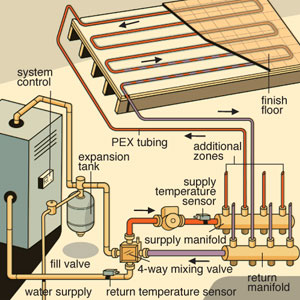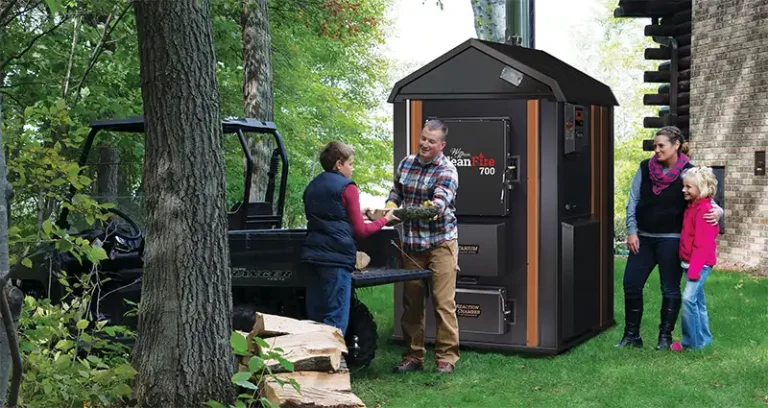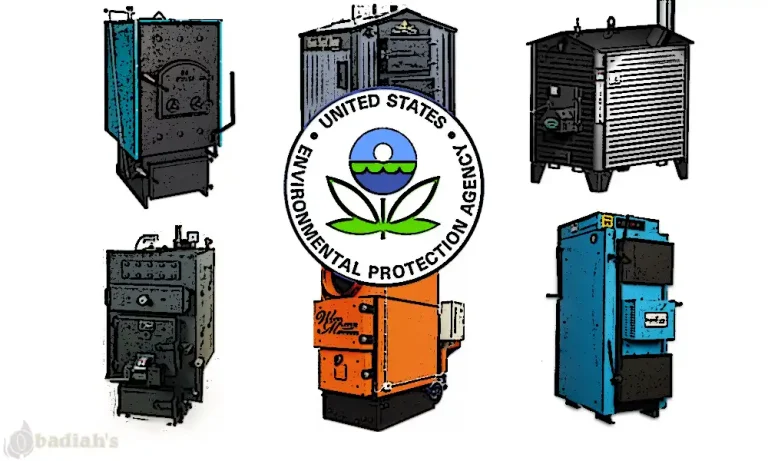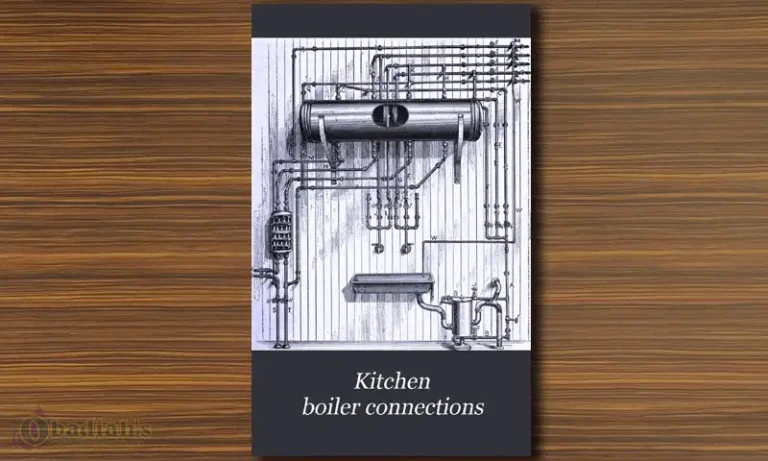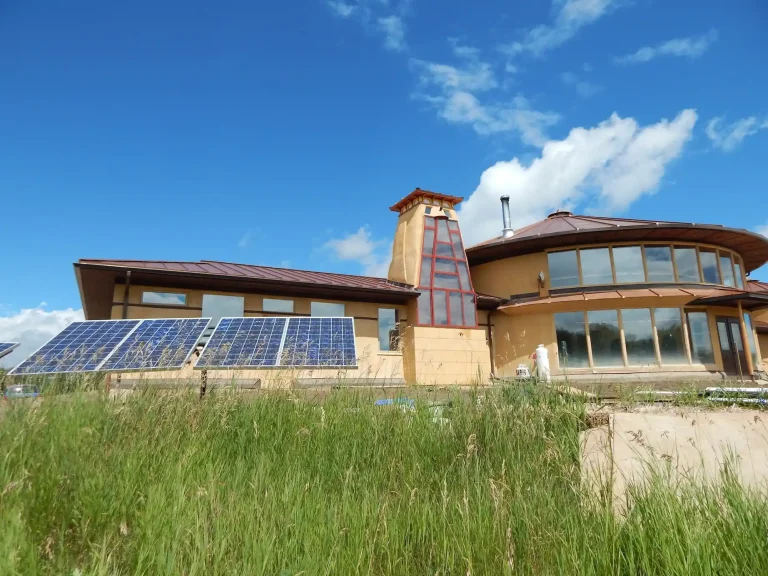In the past ten years, “Gasification Boilers” has become a popular buzzword for dealers like myself. It sounds like magic, and many companies are using the label “Gasification Boilers” to market a product to North America that, in my opinion, does not fit the actual needs or mindset of the market here: European-style batch burner boilers.
It’s been my experience that the boiler market in North America is very low-tech and focuses mostly on outdoor boilers, a technology that is very dirty burning and inefficient. That inefficiency, combined with their growing popularity, has put the outdoor boiler in the EPA’s cross-hairs for elimination (at the moment, they are still allowed for agricultural markets where there is no local regulation for particulate output; for more information, please read Obadiah’s article here on how the EPA’s regulations affect users in the United States).
Why are outdoor boilers popular, then? They’re made in America, and most folks here just want their boiler to work with as little effort on their part as possible. They wax their toys, not their boilers, and want value over having to take a second mortgage out on a boiler system. The market that Obadiah’s serves wants clean and efficient burning, but there are precious few options for them that don’t involve breaking the bank and a ton of maintenance.
This is where the term “Gasification Boilers” gets abused at the expense of the customer.
Combustion can only occur when three things are present: Fuel, an ignition source, and oxygen. It is the combination of these three factors that determine the outcome and intensity of combustion. Remove any of these factors and the combustion (fire) goes out. It’s that simple, folks. Every firefighter involved in Wildland Fire Suppression will tell you that is how we fight fire: with water, foam, or sometimes even fire itself. Gasification is a process in the combustion stage: Solid matter is converted to a gaseous state by exposing it to high temperatures and a controlled amount of oxygen, without allowing it to combust. It’s not magic. This process is also used in today’s EPA woodstoves that are burning extremely clean and efficiently without defying physics. In these stoves, gasification happens through the use of thermodynamics: When air is introduced into the combustion chamber (firebox), it creates a vacuum behind it (draft). The draft sucks in air through special tubes and channels that have been engineered into the firebox at strategic locations. This air helps create a hotter, and therefore cleaner, burn rate. A quick example of this can be done by taking some combustible materials like paper or dried leaves and lighting it on fire. Then, take a straw and gently blow air into the base of the fire. What happens? The fire will build in intensity and as it burns hotter, it burns cleaner, with less smoke. When you compare this simple process of combustion found in a woodstove to that of a “gasification” boiler burning wood in a firebox with a secondary combustion chamber below the fuel source providing pressure, it’s clear that gasification is much more complicated. It takes the use of electronics, computers, nozzles, special refractory, blowers, and a whole slew of other sensors to regulate the combustion process. If there are issues with any of these mechanical, electrical, or computerized processes, guess what happens to the combustion process? Physics takes over again, and you’re likely left without any heat.
Almost all gasification boilers today are “batch burners”, meaning they only burn at a high rate and must store BTUs in a water storage system. These storage systems can get very expensive and complicated, and only truly work best if you are doing hot water via solar power and have a high-efficient low-temperature modern hydronic radiant heating system that operates below 105 degrees. Typically this would be an in-floor radiant heating system, but unfortunately, most folks in North America today are using forced-air HVAC systems, and not radiant in-floor.
So in an effort to help buyers make an educated decision, I’ve put together the following eight simple issues to consider if you are looking at purchasing a European-style batch burner boiler that requires water storage to function properly.
1. Expense. A batch burner boiler’s water tanks are expensive and need to be installed properly to work. The rule of thumb is, in structures north of the Mason Dixon Line, the square feet of the space you are heating should be your thermal battery. The further north you are, the more water storage you will need to realize an advantage and make the expense worthwhile. For example, if you have a 1200 sq. ft. home, you will need 600 gallons of water storage to receive any benefit, otherwise you’ll pull the BTUs down so fast you will be re-firing the boiler every few hours.
2. Heating systems. If you have radiant in-floor heat, the water going through the floor is anywhere from 102 to 108 degrees, depending on how well insulated the home is. Water boils at 212 degrees, so the water temp in the thermal battery is not stored at much above 200 degrees as steam expands rapidly and can explode! This means that you can only utilize less than 50% of the amount of BTU’s stored inside the tank with this system, and only 10-20% if you’re using forced hot air or base board radiators, which typically operate at 150-180 degrees to make heat.
3. Practicality. If you are using a forced air furnace with a water-to-air heat exchanger in the plenum, or hot water baseboards, as water goes through the heating system its temperature will be anywhere from 160 to 180 degrees. If you can only utilize a fraction of the BTU’s stored in the thermal battery, you would have to fire the boiler over and over again to keep the house warm. It’s like cutting off the pickup tube in the gas tank of your car so it only hangs down in the tank an inch or so- how far can you go before you need to stop for gas again? Even though the gas tank says you have 3/4 of a tank, you’re stuck on the side of the road because you can’t utilize the gas that is still left inside the tank.
4. Electrical Compatibility. Most batch burners are from Europe, where it is illegal to utilize a boiler that will idle. The European grid runs at 240 volts 50 Hertz, pretty consistently. The North American grid runs at 120 volts, depending on where you are on the power line from the last transformer. How well do you think European electronics hold up when operating on our grid, with all the fluctuations we experience with brown outs and voltage spikes?
5. Technical Support. European boilers are complicated and make use of computers, sensors, and other electronics that the average Joe cannot fix themselves. When something goes wrong with your boiler and the screen is blank, will you know if it is the computer, a Lambda sensor, or a simple snap disc? Calling tech support on the other side of the pond presents time zone issues, language barriers, and massive delays in shipping time when ordering replacement parts can also take a while.
6. Batch Burners rely entirely on electronics. Batch Burners defy physics, and will not work if they don’t have a computer telling them what to do. Bypassing the system and getting the boiler to work temporarily is virtually impossible in most cases, so your boiler is out of commission until you can get the proper part to fix it. Sometimes, that in itself is a guessing game, and you’ll be throwing parts at the unit until you can get it working again. Finding techs and dealers that actually know how to fix these units in my experience has been very disappointing when they actually break. They all say they can fix it, when they are taking your money, a few years down the road, it seems to be a different story.
7. Thermal Efficiency versus Combustion Efficiency. Batch Burners burn very hot by pushing the gases into a separate combustion chamber that sits below the firebox containing the wood. These gases burn at close to 2000 degrees, and water boils at 212 degrees at sea level. If you do the math and some simple reasoning, how well do you think a medium that boils at 212 degrees can absorb BTUs at 2000 degrees?
Here’s a quick experiment you can do: Take a frying pan and stick it on a stove, turn on the burner, wait 5 minutes, and then sprinkle some water in the pan. What happens? The water turns into little balls and bounces all over the pan. This is called stratification- the molecules in the pan (which is about 500 degrees) are moving very fast will not transfer with the water you sprinkled in because the water particles are moving too slow. Many batch burner boilers will boast 90% efficiencies, but this only refers to combustion efficiency, not thermal transfer rates, or the overall efficiency where a pound of wood equals so many BTUs. So imagine increasing the issue with your frying pan four-fold in a boiler and ask yourself, how could you possibly get 90% thermal transfer efficiency from a batch burner? You would have to use a medium that boils above 2000 degrees.
8. Different Home Living Expectations. Obviously, there’s a difference in culture between Europe and North America. This might not seem important at first, but when it comes to how one heats their home, these differences add up. In Europe, boilers are marketed towards individuals who have the time, space, and energy to constantly tinker with their purchase. Owning a boiler in Europe can be more of a hobby than anything, something you would do almost just to be different. That’s not what we want in North America. We want a boiler that we don’t have to spend a small fortune on, that doesn’t require regular troubleshooting; we want a boiler that can be loaded and forgotten about, so we have time to get on with the things that truly matter to us.
You see, I’m a firefighter/engineer experienced in both firefighting and equipment operations (Obadiah’s Wildfirefighters is another company I run). I’ve been engaged in fire and heating systems ever since I was a youngster working with my father over 45 years ago. I know the in’s and out’s of the products in this business, but the problems I’ve listed above with batch burner….that’s just basic physics that most folks learn in high school.
So what’s the alternative to batch burners?
Looking at today’s EPA woodstoves that use gasification and burn incredibly cleanly as well as efficiently, got me to thinking: Less parts means less stuff to go wrong, which means less unhappy customers that suddenly need to buy parts in the thick of winter just so their pipes wont freeze. If the EPA can do this with their recent woodstoves, can’t someone build a boiler using the same idea?
Well, it turns out that someone has: Glenwood (not to be confused with “Greenwood”, who is no longer in production). Their boilers are simple yet robust, clean burning but not complicated, efficient but not expensive. It is not a batch burner, does not require water storage, does not use Lambda sensors or computers to operate and instead works on a simple map program that is not overly complicated. In my opinion, what Glenwood is doing is tremendously valuable and best of all, it’s American innovation, born in the Anabaptist heartland near Lancaster, PA. Their boilers range in size from 100,000 to 1 million BTUs, with custom units available as well. You can check out more boilers from Glenwood on Obadiah’s Woodstoves, like the 7070 Multi-Fuel Boiler, here.
The Glenwood overcomes most of the issues I discussed above with European-style batch burner boilers, and it still burns clean and efficiently. Glenwood has worked hard to keep us happy at Obadiah’s, and it’s been my experience that they are an honorable company run by honorable people. After twenty years of dealing with European companies selling gasification products, I’ve decided to move away from all European boilers (with the exception of the Viessmann commercial line) and only offer units built in North American. Why the change? Obadiah’s wants happy customers when they make their purchase and years down the road.
– Woody Chain

